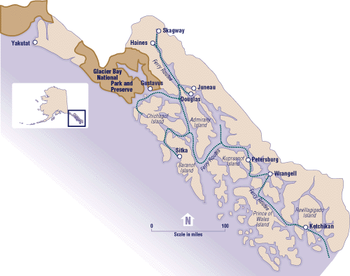October 25, 2015
St. Therese of the Child Jesus Catholic Church
(The Green Church)
(The Green Church)
St. Therese of the Child Jesus Catholic Church
Skagway, Alaska
"Gold was discovered near Dawson in the Klondike in 1896, and the town of Skagway was founded in 1897 by Captain William Moore. With the influx of miners and prospectors heading for the Klondike, Skagway quickly became the most populated town in Alaska, with a population of 3,117 in 1900.
"The first priest to visit Skagway was Father Paul Bougis SJ, from Douglas, Alaska (near Juneau). He arrived in the fall of 1897 and offered Mass in the homes of Catholic families that fall and the following spring. In August, 1898, Father Philibert Turnell SJ came to Skagway and established a mission. He made temporary arrangements to use the school for Sunday Masses, and his first Mass was offered on September 8, the Feast of the Nativity of the Blessed Virgin Mary. Three months later the Catholic community purchased a large empty store, converting it into a church and naming it St. Mark’s. The church was filled to capacity for the first Mass which was offered on Christmas Eve, 1898.
" In March of 1918, Father Edgar Gallant was the first priest to be ordained in Alaska. His first assignment was Skagway, where he was to serve until 1959. Father Gallant’s first goal was to improve St. Mark’s Church. In 1932, with help from the Catholic Extension Society, he built St. Pius X Mission Boarding School for Native children. The school stood on the site of the present Garden City R.V. Park and was staffed by the Sisters of St. Ann of British Columbia. In November of 1946, the school burned to the ground, but was soon rebuilt and operated until 1959.
"After the boarding school closed, Masses were once again offered in the homes of local Catholic families. Priests visited from Juneau, and sisters came to Skagway to visit and offer religious instruction for the children. We were once again a mission parish, but the dedication of the good people of Skagway and the visiting clergy and sisters kept the faith alive and flourishing to this day.
"Our present church—St. Therese of the Child Jesus—was built in 1979 with the help of the Christian Brothers and the good people of Skagway. Much of the funding was provided by the Catholic Extension Society, to which our community is most thankful.
Statue of St. Therese
(In front of church)
"The parish of St. Therese is a member of the Diocese of Juneau, shepherded by Bishop Edward J. Burns who was installed April 2, 2009. The Diocese of Juneau is strung out along 500 miles of islands, inlets and fjords that compose the panhandle of Southeast Alaska. This 53,000 sq. mile area is served by nine priests, many of whom travel regularly by ferry and small plane to bring the Mass and sacraments to the small towns and villages of our diocese." (Link 1.)
The residents of Skagway refer to their five churches not by their denomination, but by the color paint on the exterior.
The residents of Skagway refer to their five churches not by their denomination, but by the color paint on the exterior.
Presbyterian-White
Assembly of God-Red
Fellowship Lifelink-Gray
Mormon-Brown
St. Therese Catholic Church-Green
|
Hence St. Therese Catholic Church is identified as "The Green Church". A statue of St. Therese in front of the church welcomes church members and visitors.
The entrance/narthex is on the side of the building. Inside is the sanctuary which opens up to the church hall behind it. Behind the altar on the front wall of the sanctuary is the dramatic painting of prospectors on foot carrying their supplies up the mountain side to the gold fields. It was painted by Jerry Coon, the brother parishioner Linda Coon. It is titled Golden Stirs/Golden Staircase. Jerry Coon also helped to build the church. (Judy) A colored statue of St. Therese sits to the left of the painting.
Sanctuary
Front Wall of Sanctuary
Statue of St. Therese
(In Sanctuary)
The church hall provides additional pews for seating in the sanctuary, an area for social activities and an altar. On the side wall of the entrance to the hall is the church piano. Also on the side wall are brass plaques of the Stations of Cross.
Pews extending into church hall
(Piano on the right)
Station of the Cross
In 1932 a Catholic Boarding School for native children was built in Skagway, St. Pius X Mission Boarding School. It closed its doors in 1959. "The Chapel at the school was named in honor of St. Therese. The altar in our hall is the altar used in the Chapel in the school." (REF.)
Altar from St. Pius X School
(In church hall.)
Other architectural features in the church are a colored glass window and
the baptismal font of wood and brass.
Colored Glass Window
Baptismal Font
Thank you: To Judy and her daughter at Mile 0 B&B for information on
the church.
Note: See map of area at Blog Post October 18, 2015.
Photos: Taken in Sept. 2015 by SW while on a cruise on the Norwegian Sun.
Reference: Church handout on the history of the Church and School.


































